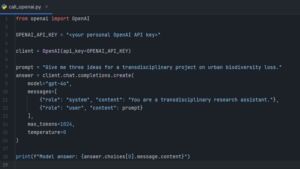The integration of artificial intelligence into transdisciplinary research opens up new possibilities in knowledge integration, participation, and science communication. At the same time, its use requires critical and responsible action. The current ISOE publication “Opportunities and Risks of Using AI Technologies in Transdisciplinary Research” highlights how AI can be usefully integrated into transdisciplinary research processes.
AI can support research, for example, in the analysis of unstructured data, hypothesis generation, and literature research. In participatory processes, it facilitates the involvement of stakeholders, the visualization of complex content, and efficient communication. In science communication, AI also offers opportunities to create texts, images, and videos, make complex content more understandable, and make knowledge more widely accessible.
At the same time, there are clear limitations and challenges: AI models can deliver erroneous or misleading results, and linking different forms of knowledge – known as strong knowledge integration – remains difficult. In addition, ethical aspects such as bias, lack of transparency, data protection issues, and social and environmental impacts must be taken into account.
Responsible use is essential
For the responsible use of AI in TDR, the authors recommend using AI as a supplement to human expertise and always critically examining its results. Wherever possible, open and transparent models should be used and ethical and participatory standards adhered to.
The publication offers practical guidance and supports informed decisions about the use of AI in transdisciplinary research projects. It is aimed at scientists and other actors in the transdisciplinary research environment.
Contact:




